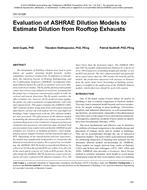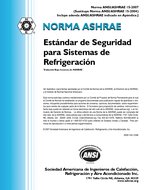Description
Re-entrainment of building exhausts may lead to poor indoor air quality, potential health hazards, worker complaints, and lower productivity. To minimize re-entrainment, the American Society of Heating, Refrigerating, and Air Conditioning Engineers (ASHRAE) recommends minimum dilution models Dr and Ds to estimate worst-case dilutions at fresh-air intakes. The Dr and Ds models predict plume center-line (worst-case) dilution at roof level, assuming that the plume has a Gaussian concentration profile in both the vertical and lateral directions.The Dr model considers the effect of plume rise; however, the Ds model assumes negligible plume rise and is primarily recommended for wall vents and capped stacks. This paper evaluates the ASHRAE (2003, 2007) dilution models using data from wind tunnel and field experiments carried out with typical low-rise and high-rise buildings. Some comparisons with the 2011 dilution models are also presented. The effectiveness of the dilution models in modeling the downwash effect of a rooftop structure (RTS) on plume dispersion is also evaluated. Comparisons between estimated and measured concentration data obtained from present and previous studies indicate that the ASHRAE model estimates are sensitive to building geometry, stack height, exhaust speed, sampler location, and the downwash effect of RTS. Depending on the interpretation and user experience, the models may significantly underpredict or overpredict the dilution level at fresh-air intakes. For a typical low-rise building, the ASHRAE 2003 Dr model overpredicted dilutions by a factor of 10 when the upwind RTS was within 15 m (49.2 ft) of the stack and by a factor of 2 with no RTS present. On the other hand, the ASHRAE 2007 Dr model was conservative for nearly all cases evaluated with dilution estimates 10 to 100 times lower than the measured values. The ASHRAE 2003 and 2007 Ds models underpredicted dilutions by a factor of 10 to 100 irrespective of building height and whether or not an RTS was present. The 2011 dilution models are generally more conservative than the 2007 model. For both Dr and Ds models, the predictions improved with increase in distance from the stack. Some basic knowledge of building aerodynamics is helpful in the application of the ASHRAE dilution models, which otherwise should be used with caution.
Citation: ASHRAE Transactions, Volume 118, Part 1, Chicago, IL
Product Details
- Published:
- 2012
- Number of Pages:
- 18
- File Size:
- 1 file , 2 MB
- Product Code(s):
- D-CH-12-026




